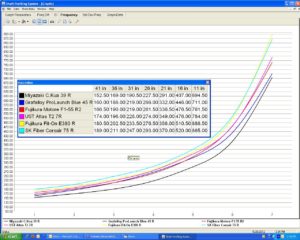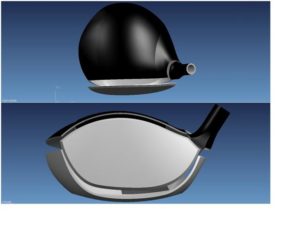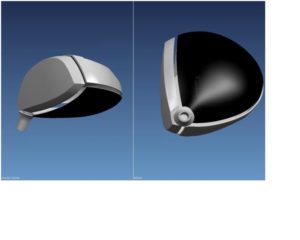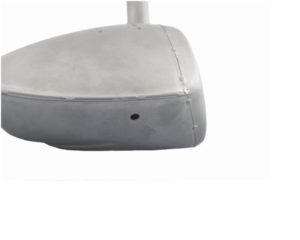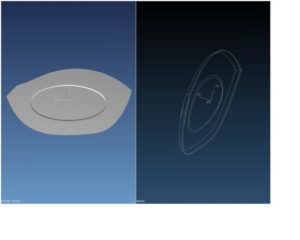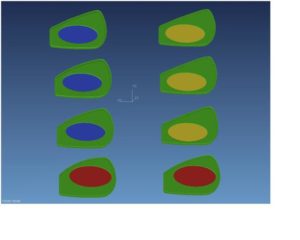Thursday, November 6, 2014
Tuesday, November 4, 2014
Tuesday, May 13, 2014
Changing Golf Shafts – Do I Use The Same Flex for Different Shafts?
Sometimes and then again, sometimes not. Sorry but that’s the truth because there are no standards in the golf industry for how stiff any of the letter flex codes are. Never have been and never will because the various golf companies don’t want that. So the R flex from one company can have the same stiffness as the S flex from another company or even the same stiffness as the A flex from a third company. Not only that, but the same flex of different shaft models within the SAME company is not necessarily going to be the same stiffness.
Sound a little confusing? Or a little bit like that’s not the way it should be?
Actually, it’s fine if each golf club company or shaft company wants to design their shafts different than another company. In doing that, they can express their own beliefs for each of their shafts should be designed.
What’s messed up is the fact that virtually none of these companies provide golfers with specific information to tell them exactly how stiff their shafts are in comparison to any other shafts. When it comes to flex, golfers are literally kept in the dark and have to adopt a “trial and error” means of determining how stiff this or that shaft is and whether it fits the golfer or not.
Since there are numerous shafts in the industry today that cost $100, $200, $300 and even more, a trial and error approach to shaft selection can get more than a little expensive. What’s the alternative? To put your shaft fitting needs in the hands of a custom Clubmaker who works with Tom Wishon Golf Technology’s proprietary shaft bend profile software.
In short, many years ago we saw the need for quantitative shaft stiffness information and created not only a measurement methodology for shaft stiffness, but a software program to allow all shafts in our data base to be compared in a way that you can definitely compare the stiffness design of many different shafts. As of mid 2012, we have over 2,000 different shafts in the TWGT Bend Profile software data base.
Here’s an example of what the information in the TWGT Bend Profile software looks like and how it works. The following data shows the range in stiffness among shafts which are sold and marked as R Flex in the golf industry today.
To translate what you are seeing, if we apply a swing speed rating to each shaft, you are looking at R flex shafts which range in swing speed rating from a 55-65mph shaft all the way up to a 110-120 mph shaft. The same goes on within all the S flex shafts in the industry as well.
Bottom line? If you want to be fit as accurately as possible for the shafts in your clubs, go get fit by a good, experienced custom Clubmaker. Especially a Clubmaker who uses this software in their shaft fitting. Clubmakers who use our TWGT Shaft Bend Profile software do a better job of fitting golfers and have a very high percentage of golfers who never have to go through an expensive trial and error process to find the best performing shaft for their swing.
How Does COR Affect Your Golf Game?
Companies, organizations and industries love to use acronyms because these abbreviations of longer terms can so easily roll off the tongue. One that has been a buzz-acronym in the golf equipment industry since 1998 isCOR – short for Coefficient of Restitution.
Experienced golfers know the COR is a number which represents how “hot” the face of their clubhead(s) is made – or rather how much distance they can get out of the shot for their swing speed. COR made its way into the golf industry’s vernacular back in 1998 when the United States Golf Association got freaked out at the distance the pros were hitting the ball. Acting before ever doing any testing, the USGA blamed the pros’ distance increase on the use of the relatively new (at that time) titanium drivers and enacted a rule that placed a limit on the COR of all driver faces.
COR is actually a measurement of the energy transfer in a collision of two objects. It can be expressed in a number between 0 and 1. For example, when the USGA put a COR limit of 0.830 on driver faces, that meant no driver would be deemed to be conforming to the rules if more than 83% of the energy in the collision of the driver head with a golf ball were transferred from the head to the ball.
COR is actually a measurement of the energy transfer in a collision of two objects. It can be expressed in a number between 0 and 1. For example, when the USGA put a COR limit of 0.830 on driver faces, that meant no driver would be deemed to be conforming to the rules if more than 83% of the energy in the collision of the driver head with a golf ball were transferred from the head to the ball.
The COR rule also became known as the “spring face rule.” This was a little unfortunate because in fact, a higher COR clubface does not really act like a spring. When you think of spring face, it is easy to think that the ball causes the clubface to flex inward, and upon flexing back out the ball is propelled as in the manner of a trampoline sling shotting a gymnast up.
Actually, higher COR faces work like this. In the collision of the clubface and the ball, there is always some energy lost. This is because the face flexes inward and the ball is compressed against the face. Both actions result in a loss of energy. Of the two, the ball loses by far the most energy when a shot is hit because it can squash as much as 30% of its diameter against the face of the driver. In a normal shot hit with an old thick face stainless steel metal wood, scientists estimate that 80% of the energy loss in such an impact came from the ball while the balance of 20% came from the clubhead.
The idea of a higher COR face design, whether done for a driver or any other clubhead, is to allow the face to flex inward a little more so that the ball is not compressed as much against the face. When that happens, the face loses a tiny bit more energy because of its increase in face flexing. But the ball then loses a lot less energy than before because it is compressed so much less because of the slight increase in face flexing.
The net result? The ball takes off at a higher velocity and flies farther for the same clubhead speed and same loft angle on the clubface. Hence high COR means more distance regardless of your clubhead speed.
And that’s how that acronym really works in the design and performance of a golf clubhead.
Golf Grip Size – How Crucial Is Grip Size to Your Golf Game?
In a word? Playing with the right grip size is HUGELY important. If the grip is too small and the golfer has to wrap his hands too far around the grip, the muscles of the forearm tighten up. When the forearm muscles get tighter, it becomes much more difficult to take the club away from the ball smoothly and then becomes more difficult to achieve a consistent swing tempo and swing rhythm.
If the grip is too large, this can impede a proper release of the wrist-cock angle on the downswing which also can prevent us from rotating the face back around to square on the downswing.
Over the years, there have been several guidelines created by various golf companies or by people who perform Clubfitting research for measuring the size of the hands and fingers, from which a proper grip size is recommended.
In addition, it has also been taught that the proper grip size is achieved when the golfer closes their hands around the grip and the finger tips come just short of touching the base of the hands. As a starting point, such charts or overlays for the hand are fine. But ultimately each golfer has to decide what their MOST COMFORTABLE grip size should be.
In short, if a hand and finger measurement chart says the grip should be one size and the golfer prefers a different size because it is more comfortable, you go with the decision for comfort – regardless what the golfer’s handicap or playing ability might be. Give you a good example. On average, my wife Mary-Ellen shoots between 95-100. Via her hand and finger measurements, she comes up on the chart for a women’s +1/64 oversize grip. Yet she much prefers and can keep her grip pressure most constant and comfortable with a men’s standard size grip. That’s the grip she plays and that’s the grip I agree as a veteran Clubfitting research person that she should play.
Perhaps the best way for clubmakers to fit grip size for comfort is simply to keep a set of different grip size samples either on cut of shaft pieces or better yet, installed on actual golf clubs. Gripping a cut off shaft section can fall a little short of giving the golfer a real sense of what a particular grip size will feel like when installed on a full length golf club. Most people have enough old clubs laying around that it would be possible to use them as your grip size samples for grip size fitting.
Remember – grip size for COMFORT FIRST so the hands and arms can maintain a secure hold on the grip without excess grip pressure or muscle contraction in the forearms.
Tuesday, February 25, 2014
Golf Club Loft – Will The Real Loft Please Stand Up
One of the very most important specifications on each of your golf clubs is the loft angle. To skip the fancy definitions, the loft angle is how much the face of the clubhead on each of your golf clubs is tilted back. Every clubhead in your bag has a specific loft angle on the face, even your putter.
Quite simply, loft is about 85% of the reason you hit each golf club a different distance. The length of each of your clubs comprises the other 15%. How far YOU actually hit each club is mainly a product of the relationship of YOUR swing speed with the different loft on each clubhead in your set – with a couple of other technical things tossed in.
One of the several definitions of a perfect set of golf clubs is that each club hit the ball a specific, different distance and that the difference in distance between each club is as close to the same as possible. Many of you know how frustrating it can be to play when you have two clubs that have a 20 yard distance difference between them and yet two others for which you only see about a 5 yard distance gap between.
When you see discrepancies in distance between clubs, the first and usually main reason this happens is because the lofts are not consistently spaced between all the clubs. Yes, there are other reasons this can happen such as length errors or things associated with how much each club weighs in relation to the others. But day in and day out, when you see inconsistent distances between clubs, it is because there is an error in the spacing of the loft angle(s) between the clubs.
So how DO you know what the lofts are on your clubs? Sorry. You can’t use a simple protractor to measure the loft on your clubs. It takes a special gauge that club designers, clubhead production factories and custom clubmakers buy and use in their work. While you can go to a the website of the company that makes the clubs you play and probably find a chart that tells you the loft on each head in your set, thanks to the fact there are definitely plus and minus tolerances, that doesn’t tell you exactly what your lofts are.
Add a really nasty thing to that as well. There are a number of golf companies who INTENTIONALLY make the real loft on their drivers to be different than what they say it is on the head! I kid you not. Since the late 90s, a few golf companies do this. Why?
Because they think they are doing golfers a favor. Here’s the deal. We all know there are some golfers out there who think they will hit the driver farther if it has a lower loft. Many golfers do not know their optimum driver loft for maximum distance has to be chosen on the basis of the golfer’s clubhead speed AND their angle of attack into the ball. Slower swing speed and/or more downward angle of attack means a higher driver loft is required to maximize distance.
Only when you have a high clubhead speed with an upward angle of attack do you get your max distance from a lower loft. Starting in the 90s, several golf companies just found it was easier to lie about the loft on their drivers and make some of their driver models with more loft than they printed or engraved on the head. More by like 2 degrees.
That’s fine I guess for the egotist golfers who refuse to buy a higher loft driver. But for the many who do want to buy the right loft, it’s a real confusing situation. Ultimately, it means to really know your lofts and to make sure your lofts match your swing, this is why it is so helpful to find and work with a competent custom Clubmaker.
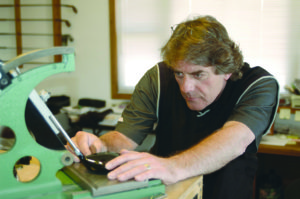
Friday, January 31, 2014
Is There Something to the Increase in Long Putter Use?
Interesting isn’t it how all of a sudden the number of tour pros making a move to a Belly putter has increased so dramatically. I mean, it’s not like longer putters are new – the “Adam Scott” style pendulum style long putters have been around for more than 20 yrs, the Belly style putters a little less.
No, this is just one more example of a trait possessed by MANY tour pros that I quickly learned back in the days when I would spend time on the tour servicing the players for whom I had designed clubs. The pros are no different than any of us. Despite how much their swing skills and competitive brains have put them where they are, they’re all looking for that magic club that can turn them overnight into a winner.
Despite the fact we golfers so often get fixated on how well these guys hit the ball, veteran golfers all know success on tour is directly proportional to how well they putt. Getting around in 26 putts or posting a 1.5 putts per GIR will cash nice checks all year long.
What gets me as a clubfitting technologist about the recent rise in Belly putter use on tour is how it has awakened the traditionalists in the game to chime in with their latest verse to demand the USGA act to outlaw long putters. These are the equipment vigilantes who claim when a putter is “anchored to the body” it gives the long putter user an unfair advantage over golfers who putt with a conventional short stick.
As a club performance scientist, this falls into the category of people who can ignore pure common sense and logic to pursue an attitude of “don’t confuse me with the facts because my mind’s already made up.”
Fact: It took 20 yrs before a long putter was used to win a major on tour. That’s somewhere around 1 in the last 80 majors.
Fact: The number of tour wins with a long putter still can be counted with the fingers on both hands. That’s somewhere substantially less than a 5% success rate.
Fact: One can still pull or push putts with a long putter. If anchoring to the body was such an advantage, wouldn’t such errant strokes be eliminated?
A point the long putter haters like to make is that a golfer who turns to a long putter is gaining an advantage because they can’t putt as well with a conventional putter so the long putter unfairly corrects that “swing error” with technology.
GEE. . . with that logic, things like going to a shorter driver to control the ball better, using a different face angle to reduce a misdirection tendency, using a different loft to counteract a different angle of attack or ANY CLUBFITTING CHANGE should be outlawed. At the end of the day, changing to a long putter is nothing more than an attempt to utilize a different fitting option to gain shot improvement.
But not to fret, as is often the case with tour players in their search for that perfect golf club, some will stay with it and many will go back to a conventional putter when the long term results show themselves. And we’ll all put this sudden increase in belly putter attention to bed and go on to the next club change trend.
Until nest time, best wishes in this great game,
Friday, January 3, 2014
Clubhead Cup Face and How it Affects Performance
All driver heads as well as some fairway wood and hybrid heads are manufactured from a number of separate pieces which are welded together to complete the final construction of the clubhead. Most common are driver heads which are manufactured from 4 separate pieces, as shown by this illustration below.
Of the separate pieces which make up the complete clubhead, one is always the clubface. Within such types of driver, fairway wood and hybrid head construction, the face can be formed to be welded to the body in two different ways, one called an EDGE WELDED face and the other referred to as a CUP FACE CONSTRUCTION.
The above illustration shows the more common of the two, an edge welded face. In the edge welded face clubhead, the face is made so that as the term states, the welding line to secure the face piece to the head body is on the very edge of the face. To contrast, the cup face is formed in a manner so the face piece is more like a cup, meaning it could hold water because the edges are angled around the face surface. In a cup face construction, the welding line to secure the cup face to the head body is not on the edge of the face, but is rather some distance back from the edge of the face. Below is an illustration of a cup face construction to contrast against the above edge welded face design.
The purpose of a cup face construction is to improve the amount of face flexing for areas off the center of the face to achieve better distance, performance and feel from off center hits. In modern clubface performance, the more the face flexes inward, the higher the speed of the ball will be coming off the face.
With an edge welded face, a portion of the actual welding bead that secures the face to the body is extends past the actual seam onto the rear surface of the face. This welding bead can extend ¼” onto the back of the face, all 360* around the face. It can act as an additional “stiffener” or “brace” to prevent the face from flexing as much inward for shots hit off the center of the face.
Since the welding line on a cup face construction is well back from any portion of the face, this means the welding bead is nowhere near any portion of the face. In addition, the inside edge of the face is more curved so there is no additional agent causing resistance to the face flexing inward. Below is a photo showing an actual cup face 4-piece driver head on which the pieces of the head and the cup face have just been initially tack welded to position the pieces for full robotic welding.
There is no question maximum ball speed comes only from impact in the center or slightly above the center of the face. But with a cup face construction, and with a variable thickness cup face construction, in contrast with a uniform thickness edge welded face, the off center hit performance can be improved remarkably.
How To Find The Best Custom Clubfitters
With the advent of adjustable hosel drivers and special order fitting options from the big golf club companies, a growing number of golfers are becoming aware that custom clubfitting exists with claims that it is a way for them to improve their play. The problem with this type of awareness among golfers about custom fitting is that it becomes too easy for uneducated golfers to be fooled into going to be custom fit by people and businesses that cannot perform the type of custom fitting that can deliver visible game improvement.
Using an adjustable hosel driver or simply ordering custom specs from a big golf company are in no way the same type of fitting referred to as FULL SPECIFICATIONS PROFESSIONAL CUSTOM FITTING. Full specifications custom clubfitting means fitting and custom building each one of the woods, irons and wedges for all 13 of the KEY fitting specifications. Not 1 or 2 clubs with 2 or 3 of the key fitting specs altered within a very limited range. Nothing less than full specs fitting will allow a golfer the greatest opportunity to experience measurable game improvement.
How do you find professional custom clubfitter who can fit for all 13 of the key fitting specifications for each club in the bag? Your odds are very slim in a big retail golf chain store. It’s not likely to be found in a golf course pro shop either. And that’s sad to say because of the large number of golfers who frequent big retail golf stores and pro shops.
You’ll find the best custom clubfitters typically working solo in their own small, independent golf shop. And yes for sure, because professional custom clubfitting is a “cottage industry”, you can also find a very good custom clubfitter working from the basement or garage of their home. In fact, there have been past winners of the industry’s Clubfitter of the Year award who operate their fitting business from a shop in their home.
If you want to be fit the RIGHT way by a person with real knowledge and skill in professional Clubfitting, there are three places you can go to find out if there is a good, experienced clubfitter in your area.
This is the Clubmaker locator of the Association of Golf Clubfitting Professionals. The AGCP is one of the two trade organizations of professional custom clubmaker/clubfitters. The AGCP consists of the best of the best of the independent custom clubmakers in the world. In short, if you are fit by an AGCP Clubmaker, you most definitely will have been fit by a very good, very knowledgeable person.
This is the member directory for the International Clubmakers’ Guild, the second of the two trade organizations of professional custom clubmaker/clubfitters. Many of the ICG clubmakers came from the former Professional Clubmakers’ Society and also represent people with a lot of experience in full specifications custom Clubfitting. In addition, the ICG offers accreditation certification so when you find an accredited ICG member, you have found a very good person you can trust to fit you properly.
This is the link to my company’s Clubmaker Locator. These are clubmakers that we have screened, that we know, and in many cases that I have personally trained in the past to offer golfers a full specifications, professional fitting experience.
Between all three links, most golfers should be able to find a competent clubfitter within a reasonable distance to where they live. Of course, there will be areas of the country not served by a full specifications custom clubfitter. But I can tell you if you are interested in having your clubs fit so that you have the most chance of game improvement and the best chance to play to the very best of your given ability, that’s going to happen from a Clubmaker you’ll find through one of these three sources and not through a big retail golf store or pro shop.
How Does A Variable Thickness Face Affect Off Center Hits?
In the world of club face design, there is what are called “uniform thickness faces” and there are “variable thickness faces.” A face designed to be uniform in thickness is just that – the face is manufactured so the entire face has the same dimensional thickness.
To contrast, a variable thickness face is manufactured so a specific area of the center of the face is slightly thicker than the surrounding area around the center of the face. Below is an illustration of a typical variable thickness face design from one of my driver head designs.
In this case, you can see that the oval shaped center area is made to be a little thicker than the perimeter surrounding area. The purpose of a variable thickness face is to achieve more face flexing when the ball is hit off center while still having the proper amount of face flexing in the center of the face to keep the face within the USGA’s maximum limit for COR (coefficient of restitution) in the Rules of Golf.
The concept is to make the surrounding area thin enough so that when the ball is hit off center, the thinner perimeter area will offer less resistance to the face flexing, which in turn will increase the ball speed for the off center hit. The thicker center area is necessary to prevent a center impact from flexing too much to either exceed the USGA’s limit for the COR of the face or cause potential permanent deformation of the face.
How large the thicker to thinner areas, the shape of the thick to thin areas, and exactly how thick and thin they need to be are all areas that have to be researched for each different size or different shaped face area. TWGT is the first to have commercially developed a variable thickness face in the golf industry for a titanium driver in 1995. All TWGT driver models developed since the company was founded in 2003 have had a variable thickness face to improve off center hit distance, performance and feel.
The variable thickness face concept also can be engineered to improve off center face impacts in a set of irons. First pioneered for an iron design by TWGT in 2004 with our 770CFE irons and continued with our current 870Ti irons, the variable thickness iron face concept takes more work to determine the precise specifications because iron faces change in size through the set. In addition, iron faces are not symmetrically shaped as are wood and driver faces so this too requires a difference in the design of the thick to thin areas of the faces. Below is an illustration to show how each of the faces in the original 770CFE set of irons required the position of the thick to thin areas to change from the #3 iron to the pitching wedge in the design.
Subscribe to:
Posts (Atom)

